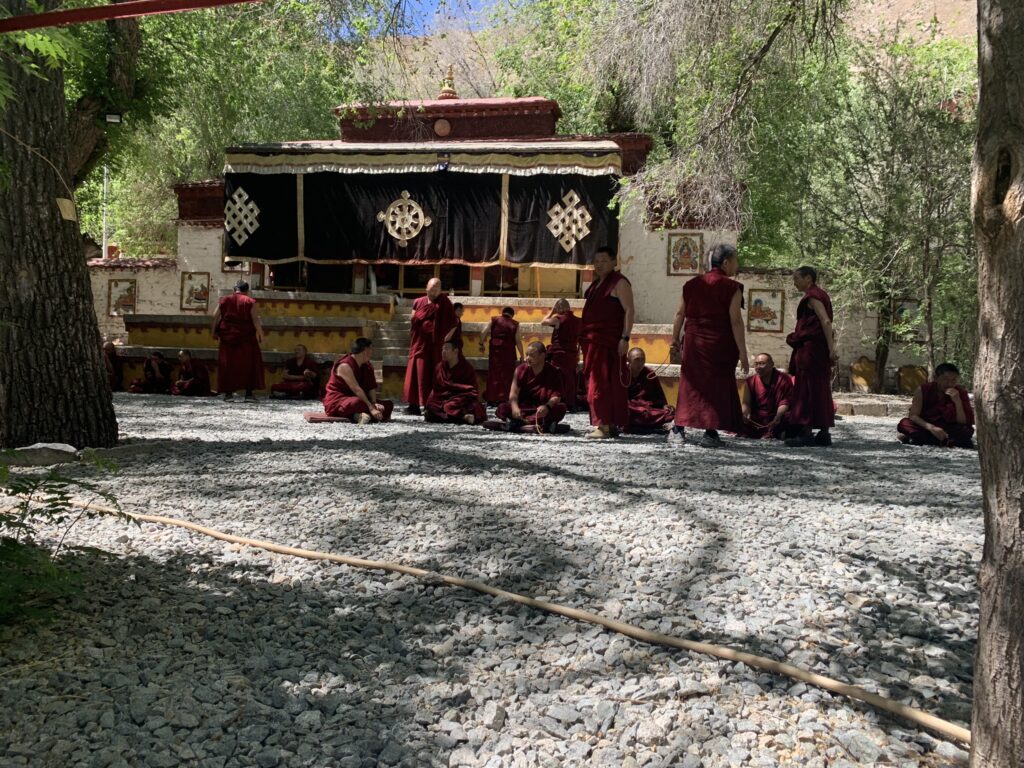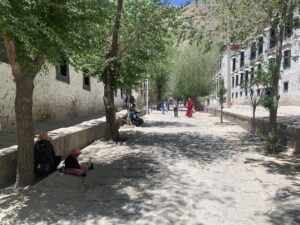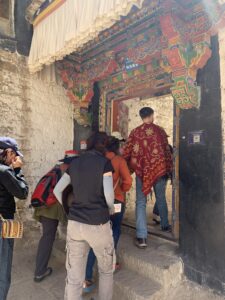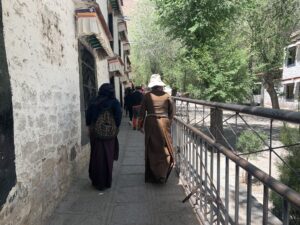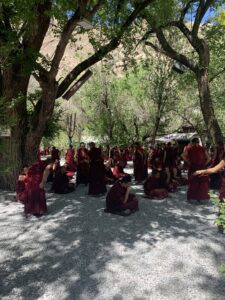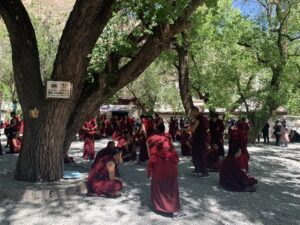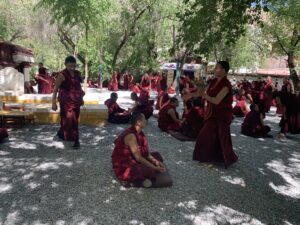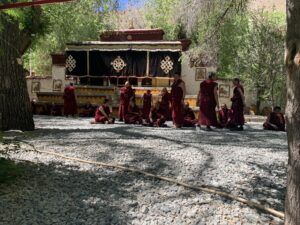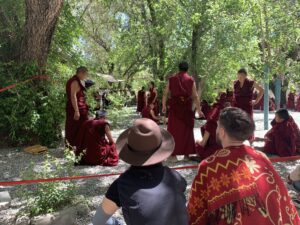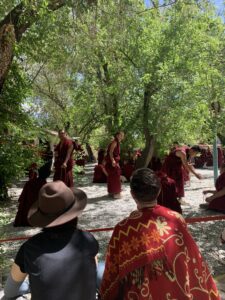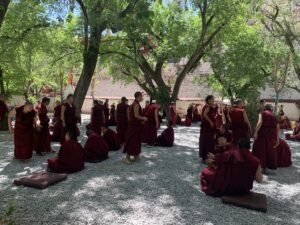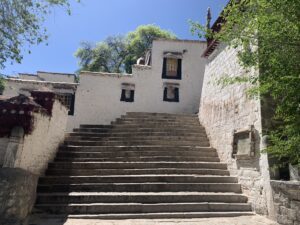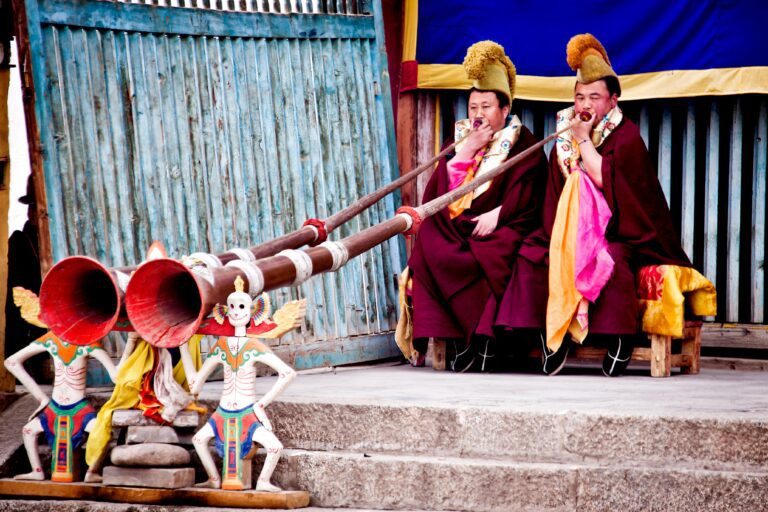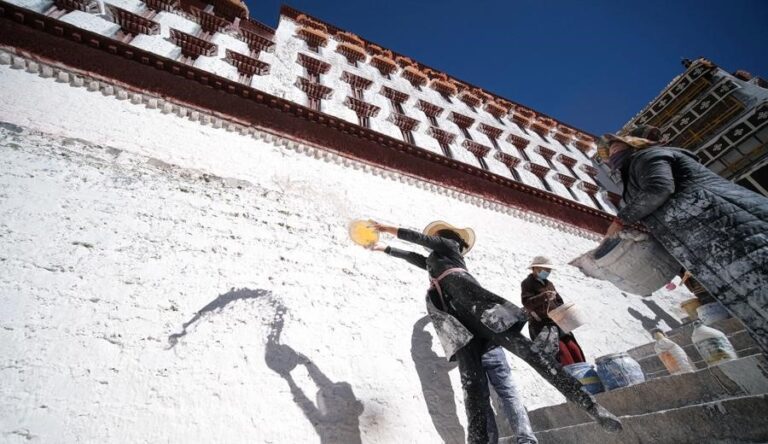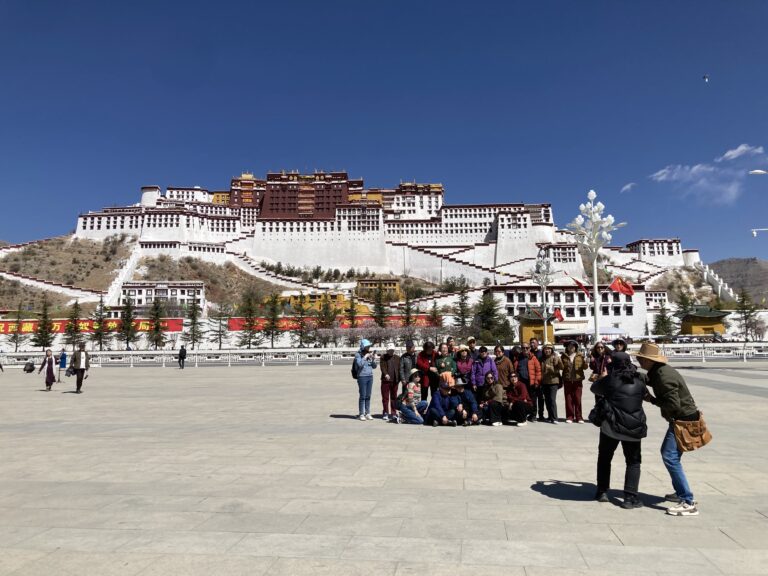In the northern outskirts of Lhasa, nestled against the dramatic backdrop of the Tibetan mountains, stands one of Tibet’s most fascinating and dynamic monastic institutions – Sera Monastery. As the third member of the renowned “Great Three Temples” of Tibet, Sera Monastery offers visitors a unique opportunity to witness living Buddhist tradition through its famous daily debate sessions, where monks engage in animated philosophical discussions that have continued for over 600 years.
The Great Three Temples of Tibet
Sera Monastery holds a prestigious position as one of Tibet’s “Great Three Temples,” alongside Drepung and Ganden monasteries. These three institutions represent the pinnacle of Gelug school Buddhist education and have served as the primary centers of monastic learning in Tibet for centuries. Together, they form the foundation of Tibetan Buddhist scholarship and continue to preserve ancient traditions of philosophical inquiry and spiritual practice.
Located in the northern part of Lhasa, Sera Monastery provides a perfect complement to visits to other sacred sites like the Potala Palace and Jokhang Temple. The monastery’s strategic location offers stunning views of the surrounding valley while maintaining the peaceful atmosphere essential for contemplative study and practice.
The Famous Monk Debates: A Living Tradition
Daily Philosophical Discussions
The most captivating feature of Sera Monastery is undoubtedly its daily Buddhist debates, a practice that forms a notable highlight for visitors to this sacred temple. Every day except Sundays and during special events, monks gather in Sera’s historic courtyard to engage in animated discussions about Buddhist philosophy, theology, and doctrine.
These debates typically take place between 3 PM and 5 PM, providing visitors with a scheduled opportunity to witness this remarkable tradition. The timing allows for optimal lighting in the courtyard and fits within the monastery’s daily routine of prayers, study, and meditation.
The Art of Buddhist Argumentation
The debate sessions at Sera Monastery represent far more than simple academic discussions. They embody a sophisticated educational method that has been refined over centuries to sharpen monks’ understanding of Buddhist concepts. The debates involve:
- Logical Reasoning: Monks must present coherent arguments supported by scriptural authority
- Quick Thinking: Participants must respond immediately to challenges and counter-arguments
- Physical Expression: Dramatic gestures, hand clapping, and animated movements accompany verbal exchanges
- Scriptural Knowledge: Deep familiarity with Buddhist texts is essential for effective participation
- Respectful Competition: Despite the intensity, debates maintain an atmosphere of mutual respect and learning
Witnessing the Debates
For visitors, watching the monk debates provides an extraordinary window into Tibetan Buddhist education and philosophy. The sight of maroon-robed monks engaged in passionate intellectual exchange, punctuated by dramatic gestures and the sound of clapping hands, creates an unforgettable experience that brings ancient traditions to life.
The debates are conducted in Tibetan, but the universal language of intellectual passion and the monks’ animated expressions make the experience accessible to visitors regardless of language barriers. Many travelers describe witnessing these debates as one of the highlights of their Tibet journey.
Historical Background and Significance
Foundation and Development
Sera Monastery was founded in 1419 by Jamchen Chojey, a disciple of Tsongkhapa, the founder of the Gelug school of Tibetan Buddhism. The monastery’s name “Sera” means “wild rose” in Tibetan, derived from the wild roses that bloomed on the hill where the monastery was built.
Over the centuries, Sera Monastery grew to become one of the largest monastic institutions in Tibet, housing thousands of monks at its peak. The monastery complex expanded to include multiple colleges, temples, and residential quarters, creating a self-contained community dedicated to Buddhist study and practice.
Educational Tradition
Sera Monastery has always been renowned for its rigorous educational programs. The monastery operates several colleges (dratsang) that specialize in different aspects of Buddhist learning:
- Sera Je College: Focuses on philosophical studies and debate training
- Sera Me College: Emphasizes tantric studies and advanced practices
- Ngagpa College: Dedicated to esoteric Buddhist practices
This comprehensive educational structure ensures that monks receive thorough training in all aspects of Buddhist doctrine and practice, from basic philosophy to advanced meditation techniques.
Architectural Features and Sacred Spaces
Traditional Tibetan Architecture
Sera Monastery showcases classic Tibetan monastic architecture, with its distinctive white walls, golden roofs, and colorful decorative elements. The complex includes numerous buildings arranged around courtyards, creating intimate spaces for study, debate, and ceremony.
The main assembly hall can accommodate hundreds of monks for daily prayers and special ceremonies. Its interior features elaborate murals, traditional thangka paintings, and statues of Buddhist deities that create an atmosphere of profound spirituality.
The Debate Courtyard
The monastery’s debate courtyard serves as the focal point for the famous philosophical discussions. This open space, surrounded by traditional buildings, provides the perfect setting for the animated exchanges between monks. Ancient trees offer shade during summer months, while the courtyard’s design ensures excellent acoustics for the debates.
Sacred Chapels and Shrines
Throughout the monastery complex, visitors will find numerous chapels and shrines dedicated to different Buddhist deities and historical figures. These sacred spaces house precious statues, scriptures, and ritual objects that have been preserved for centuries. Each chapel tells part of the monastery’s story and contributes to the overall spiritual atmosphere.
The Monastic Community
Life at Sera Monastery
Sera Monastery remains an active monastic community where hundreds of monks continue their studies and practice. The daily routine includes:
- Morning Prayers: Gathering in the assembly hall for chanted prayers
- Study Sessions: Individual and group study of Buddhist texts
- Debate Practice: The famous afternoon philosophical discussions
- Meditation: Personal contemplative practice
- Ritual Ceremonies: Participation in various Buddhist observances
Educational Programs
The monastery continues its traditional role as an educational institution, offering comprehensive programs in Buddhist philosophy, meditation, and ritual practice. Monks typically spend many years progressing through different levels of study, culminating in advanced degrees equivalent to doctorate-level education in Buddhist studies.
Visiting Sera Monastery
Planning Your Visit
Sera Monastery is easily accessible from central Lhasa and is typically included in comprehensive Tibet tours such as the holy city tours offered by Experience Tibet. The monastery is often visited in combination with other significant sites like the Potala Palace and Jokhang Temple, providing a complete picture of Tibetan Buddhist culture.
Best Time to Visit
To witness the famous monk debates, plan your visit to arrive at the monastery by 3 PM. This timing ensures you’ll experience the full debate session, which typically lasts until around 5 PM. The debates occur daily except on Sundays and during special religious events, so check the schedule when planning your visit.
What to Expect
A typical visit to Sera Monastery includes:
- Guided Tour: Expert guides explain the monastery’s history and significance
- Debate Observation: Watching the famous philosophical discussions
- Chapel Visits: Exploring sacred spaces and viewing religious artifacts
- Photography Opportunities: Capturing the dramatic architecture and debate scenes
- Cultural Education: Learning about Tibetan Buddhist practices and beliefs
Respectful Visiting
When visiting Sera Monastery, remember that it remains an active religious site. Visitors should:
- Dress Modestly: Cover shoulders and avoid shorts or revealing clothing
- Maintain Quiet: Speak softly and avoid disrupting prayers or study
- Follow Photography Rules: Respect restrictions on interior photography
- Observe from Distance: Don’t interfere with debate sessions or religious activities
- Remove Hats: Show respect when entering sacred spaces
Sera Monastery in Context
Part of Lhasa’s Spiritual Circuit
Sera Monastery forms an essential component of any comprehensive exploration of Lhasa’s spiritual sites. The monastery complements visits to:
- Potala Palace: The iconic symbol of Tibetan Buddhism
- Jokhang Temple: Tibet’s most sacred temple
- Drepung Monastery: Another member of the Great Three Temples
- Barkhor Street: The ancient pilgrim circuit
This combination provides visitors with a complete understanding of Tibetan Buddhist culture, from the institutional authority of the Potala Palace to the grassroots religious practice visible at neighborhood temples and monasteries.
Educational Value
Visiting Sera Monastery offers unique educational opportunities that extend beyond typical sightseeing. The experience provides insights into:
- Buddhist Philosophy: Understanding the intellectual traditions of Tibetan Buddhism
- Monastic Life: Observing how monks live, study, and practice
- Tibetan Culture: Experiencing living traditions that have continued for centuries
- Educational Methods: Witnessing ancient teaching techniques still in use today
Photography and Documentation
Capturing the Debate Sessions
The monk debates at Sera Monastery provide extraordinary photography opportunities. The animated gestures, flowing robes, and dramatic expressions create compelling images that capture the essence of this ancient tradition. The afternoon lighting in the courtyard is particularly favorable for photography.
Architectural Photography
The monastery’s traditional architecture offers numerous photographic subjects, from sweeping views of the entire complex to detailed shots of decorative elements. The contrast between the white walls and colorful decorative features creates visually striking compositions.
Respectful Documentation
When photographing at Sera Monastery, always be respectful of the monks and religious activities. Ask permission when photographing individuals, and be aware that some areas may have photography restrictions. The goal should be to document the experience while maintaining the dignity and sanctity of this sacred space.
Cultural and Spiritual Significance
Preserving Ancient Traditions
Sera Monastery plays a crucial role in preserving Tibetan Buddhist traditions that might otherwise be lost. The continuation of debate practices, educational programs, and religious observances ensures that ancient knowledge passes to new generations of practitioners.
Living Heritage
Unlike many historical sites that serve primarily as museums, Sera Monastery remains a living center of religious and educational activity. This vitality adds authenticity to the visitor experience and demonstrates the ongoing relevance of Tibetan Buddhist culture.
International Recognition
The monastery’s significance extends beyond Tibet, attracting scholars, spiritual seekers, and cultural enthusiasts from around the world. The debate tradition, in particular, has gained international recognition as a unique form of educational practice that combines intellectual rigor with spiritual development.
Conclusion: A Window into Living Buddhism
Sera Monastery offers visitors an unparalleled opportunity to witness Tibetan Buddhism as a living, breathing tradition rather than a historical artifact. The famous monk debates provide a dramatic and educational experience that brings ancient philosophical traditions to life, while the monastery’s continued role as an active educational institution demonstrates the enduring relevance of Tibetan Buddhist culture.
Whether you’re drawn by intellectual curiosity about Buddhist philosophy, fascination with unique educational methods, or simply the desire to witness one of Tibet’s most distinctive cultural practices, Sera Monastery delivers an unforgettable experience. The sight of monks engaged in passionate philosophical debate, surrounded by centuries-old architecture and maintained traditions, creates memories that last long after your visit ends.
As part of a comprehensive exploration of Lhasa’s spiritual sites, Sera Monastery provides essential context for understanding Tibetan Buddhist culture. Plan your visit to coincide with the afternoon debate sessions, and prepare to witness one of the world’s most unique and captivating religious and educational traditions.


